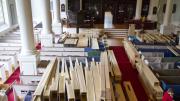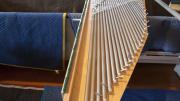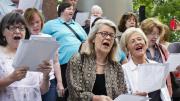Curious tourists peeking through the open doors of Memorial Church this summer will see neat stacks of lumber and many, many pipes. They won’t see churchgoers; instead, they may hear a hustle and bustle in the rear gallery—the installation of the church’s newest organ, Fisk Opus 139.
The Opus 139 is the larger of two organs replacing the old Fisk Opus 46, which has served Memorial Church since 1967 but never quite fit the space musically. (The numerals connote the number of organs the company has produced.) Opus 46 had to perform double duty, accompanying the choir for small daily services in Appleton Chapel and filling the main sanctuary for larger services. “The instrument was compromised in both settings—too loud for the chapel and too small for the main sanctuary,” says Edward Jones, Harvard’s Gund University organist and choirmaster. When Jones arrived in 2003, he and then Pusey minister Peter J. Gomes began discussing solutions to the musical problem, eventually settling on two organs. The smaller organ, a refurbished 1929 instrument constructed by the famous organ maker E.M. Skinner, was installed in Appleton Chapel and unveiled last November. Opus 139, with three manuals and 53 stops, will fill the larger sanctuary with its swelling sounds.
Pieces of Opus 139 are arriving by truck from organ company C.B. Fisk’s shop in Gloucester, Massachusetts. On June 20, congregation members gathered to greet the first of five truckloads with a hymn. Sunday services are canceled for the summer; the installation will be completed by fall, but the vast project of “voicing” or tuning the organ’s more than 3,000 pipes, will take several months more. The instrument’s debut is planned for Easter Sunday, 2012.
For no other instrument are music and architecture so intimately entwined, says Christian Lane, assistant University organist and choirmaster. The acoustics of the church must be taken into account when designing the organ: “Half the instrument is the space it’s in,” says Lane. Conversely, the organ’s sheer size makes its placement and design integral features of the church architecture. Removing the old Opus 46 restored a view of the east-facing Palladian windows, bathing Appleton Chapel in morning light. (The pipes of the smaller Skinner organ now sit behind the screened walls of the chapel.) Opus 139 is being built in the rear gallery, where Charles Brenton Fisk ’49, designer of the original Opus 46, wanted his organ to be placed.
Fisk, the namesake and founder in 1961 of C.B. Fisk Inc., grew up in Cambridge and studied physics in college. (At 18, he was working with J. Robert Oppenheimer ’25, S.D. ’47, on the Los Alamos project.) But eventually he chose to pursue his interest in music and organ-building. The Opus 46 was the largest four-manual tracker organ in America at its time, and Fisk was immensely proud of it, even voicing it personally, yet he was also disappointed in its less-than-ideal acoustic placement, and would probably be pleased that its new home, a Presbyterian church in Austin, Texas, is in a space that Jones says is much better suited to its size.
Despite Fisk’s long ties with Harvard, choosing his firm to build the new organ was not a done deal, Jones is careful to emphasize. The company was keen to respect Memorial Church’s history and unique space constraints. “You have to harmonize with the existing architecture of building,” says Greg Bover, vice president of C.B. Fisk and project manager for the new organ. Bover notes, for example, that the utmost care was taken in the details, such as the choice of wood and finish (selected, Bover says, to "harmonize" with the colors of the church's interior, including the wood of the 1932 screen and pulpit). The pipes that extend into an attic vault are part of the “Swell” division and are contained in a large louvered cabinet; the organist can open or close the louvers while playing, resulting in a “swelling” sound from which the division gets its name.
Fisk was noted for reintroducing tracker organs, which had fallen out of fashion. The valves of a tracker organ are mechanically controlled – pushing a key moves the tracker, a thin rod, that opens a valve to allow air flow through the organ’s pipe. All this mechanical action means that tracker organs offer the organist much greater control over the speech of the pipes, but can be more demanding to play than electro-pneumatic instruments, where the valves are controlled by electricity. Trackers were traditionally made from thin slips of wood, but Opus 139’s are made from carbon fiber, which is light, strong, and stable. Says Bover: “We build organs the traditional way, but we use the most modern technology.” (A documentary film, Opus 139: To Hear the Music, will also tell the instrument's story.)
The restored Skinner organ in Appleton Chapel is electro-pneumatic, bearing the hallmarks of its 1920s origin. At that time, it was in vogue for organs to sound like orchestras. “The Skinner mimics orchestral colors,” says Jones, “every sound trying to meld seamlessly like an orchestra.” The primary role of the Skinner organ, with its mellow sounds, will be to accompany the choir during morning prayers, while the Fisk organ will be a versatile instrument used for services and recitals, capable of providing gentle background sounds and filling the church with grand ones.
Before the old Fisk Opus 46, another Skinner organ served Memorial Church, and that organ also proved unsatisfactory as musical accompaniment for both main sanctuary and chapel. There is an elegant symmetry to the solution of two new organs from the same two legendary builders: one tracker Fisk organ and another Skinner electro-pneumatic one. Jones says, “We will be blessed with having two of the finest examples of both types of organs in this building.”
“This is part of Peter’s legacy of restoring Appleton Chapel,” adds Jones. Gomes, who passed away in February from complications due to a stroke, had long wanted the chapel to be returned to its original architecture. He backed the acquisition of the new organs and worked tirelessly to raise the $6 million needed to pay for their installation. Although he did not live to see the project’s completion, his influence can be seen and will soon be heard throughout Memorial Church.











